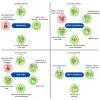Expert Consensus Statement on Simplified Glycemic Care in Patients With Type 2 Diabetes Mellitus
- PMID: 40741551
- PMCID: PMC12307720
- DOI: 10.7759/cureus.87002
Expert Consensus Statement on Simplified Glycemic Care in Patients With Type 2 Diabetes Mellitus
Abstract
The growing burden of type 2 diabetes mellitus (T2D) in India, characterized by rising prevalence, complex treatment regimens, and substantial economic and psychological impact, necessitates a simplified, patient-centered approach to glycemic management. This expert consensus document presents evidence-based recommendations for streamlined glycemic care focused on enhancing treatment adherence, minimizing pill burden, and improving clinical outcomes. An expert panel of endocrinologists and diabetologists convened across eight advisory board meetings to review current evidence and generate practical strategies. Emphasis was placed on the early use of combination therapies, particularly sodium-glucose cotransporter-2 (SGLT-2) inhibitors and dipeptidyl peptidase-4 (DPP-4) inhibitors, with or without metformin, tailored to individual patient profiles. The consensus underscores the importance of fixed-dose combinations (FDCs) to improve adherence and cost-effectiveness. In addition to pharmacologic strategies, lifestyle interventions, including medical nutrition therapy, physical activity, and sleep hygiene, are advocated. Special considerations are provided for managing T2D with comorbid conditions such as cardiovascular disease, chronic kidney disease, hypertension, obesity, and dyslipidemia, emphasizing the pleiotropic benefits of SGLT-2 inhibitors and glucagon-like peptide-1 (GLP-1) receptor agonists. The recommendations also address barriers in the Indian healthcare landscape, including limited access to care and treatment inertia. This consensus aims to support clinicians, researchers, and policymakers in implementing an integrative, simplified care model that addresses the multifaceted challenges of T2D management in India. By adopting these recommendations, healthcare providers can enhance patient outcomes, reduce complications, and alleviate the socioeconomic burden of T2D.
Keywords: combination therapy; dipeptidyl peptidase-4 (dpp-4) inhibitors; lifestyle modifications; monotherapy; sodium-glucose cotransporter-2 (sglt-2) inhibitors; type 2 diabetes mellitus (t2d).
Copyright © 2025, Sethi et al.
Conflict of interest statement
Conflicts of interest: In compliance with the ICMJE uniform disclosure form, all authors declare the following: Payment/services info: All authors have declared that no financial support was received from any organization for the submitted work. Financial relationships: All authors have declared that they have no financial relationships at present or within the previous three years with any organizations that might have an interest in the submitted work. Other relationships: All authors have declared that there are no other relationships or activities that could appear to have influenced the submitted work.
Figures



Similar articles
-
Prescription of Controlled Substances: Benefits and Risks.2025 Jul 6. In: StatPearls [Internet]. Treasure Island (FL): StatPearls Publishing; 2025 Jan–. 2025 Jul 6. In: StatPearls [Internet]. Treasure Island (FL): StatPearls Publishing; 2025 Jan–. PMID: 30726003 Free Books & Documents.
-
SGLT-2 inhibitors or GLP-1 receptor agonists for adults with type 2 diabetes: a clinical practice guideline.BMJ. 2021 May 11;373:n1091. doi: 10.1136/bmj.n1091. BMJ. 2021. PMID: 33975892
-
Preexisting Diabetes and Pregnancy: An Endocrine Society and European Society of Endocrinology Joint Clinical Practice Guideline.J Clin Endocrinol Metab. 2025 Aug 7;110(9):2405-2452. doi: 10.1210/clinem/dgaf288. J Clin Endocrinol Metab. 2025. PMID: 40652453 Free PMC article.
-
Preexisting Diabetes and Pregnancy: An Endocrine Society and European Society of Endocrinology Joint Clinical Practice Guideline.Eur J Endocrinol. 2025 Jun 30;193(1):G1-G48. doi: 10.1093/ejendo/lvaf116. Eur J Endocrinol. 2025. PMID: 40652450
-
The evolution of type 2 diabetes management: glycemic control and beyond with SGLT-2 inhibitors and GLP-1 receptor agonists.J Osteopath Med. 2023 Nov 3;124(3):127-135. doi: 10.1515/jom-2023-0179. eCollection 2024 Mar 1. J Osteopath Med. 2023. PMID: 37921061 Review.
References
-
- The Diabetes Atlas. [ Sep; 2024 ]. 2021. https://diabetesatlas.org https://diabetesatlas.org
-
- Metabolic non-communicable disease health report of India: the ICMR-INDIAB national cross-sectional study (ICMR-INDIAB-17) Anjana RM, Unnikrishnan R, Deepa M, et al. Lancet Diabetes Endocrinol. 2023;11:474–489. - PubMed
Publication types
LinkOut - more resources
Full Text Sources
Miscellaneous
